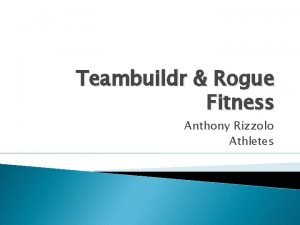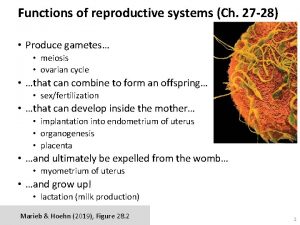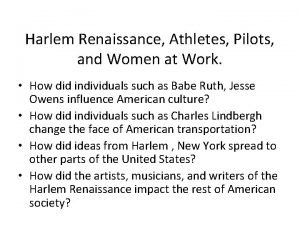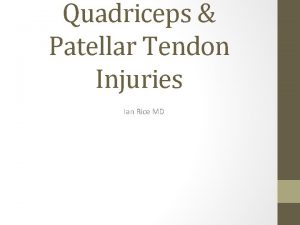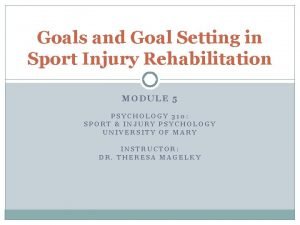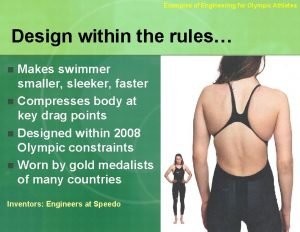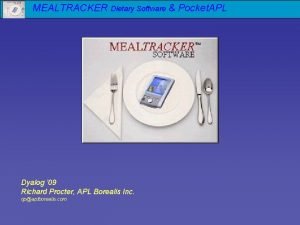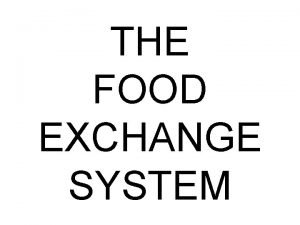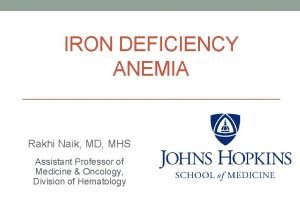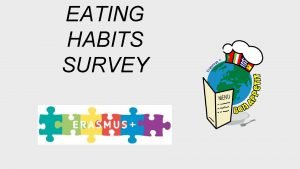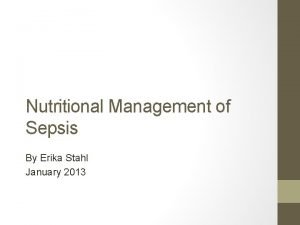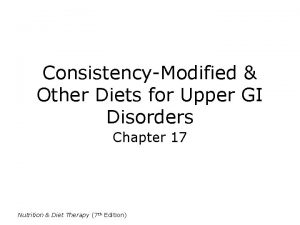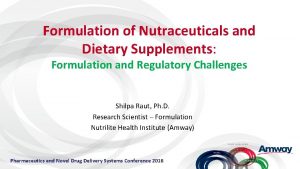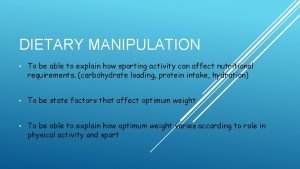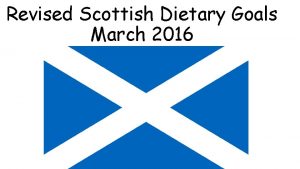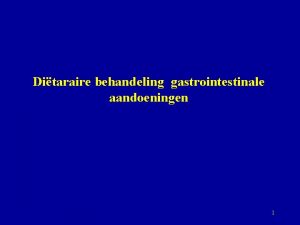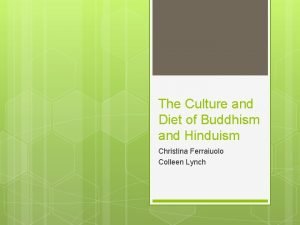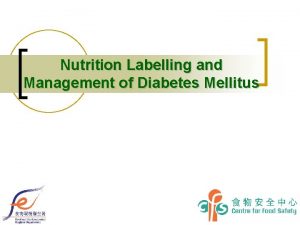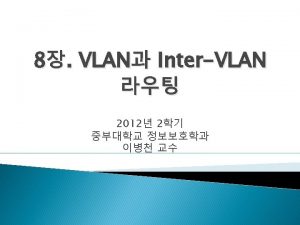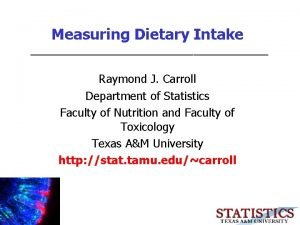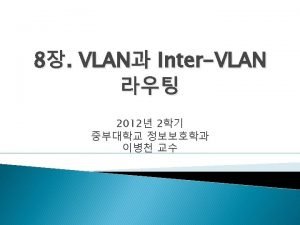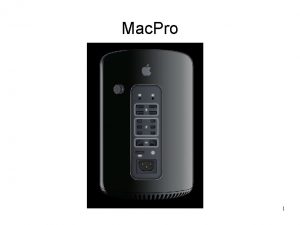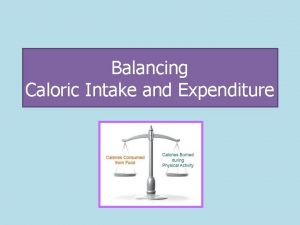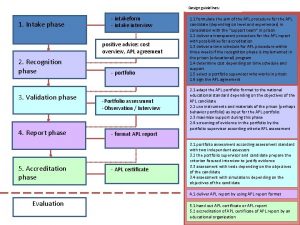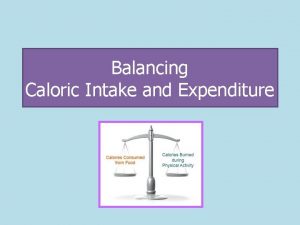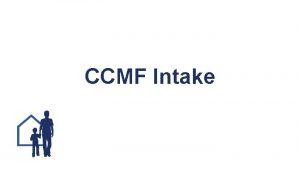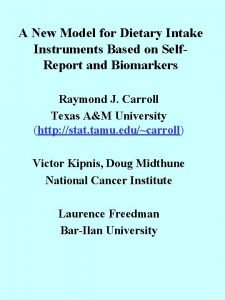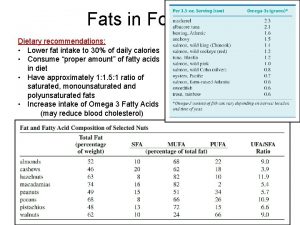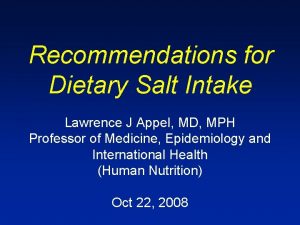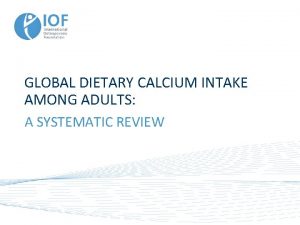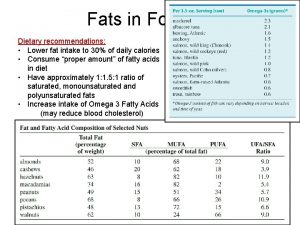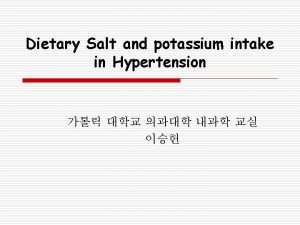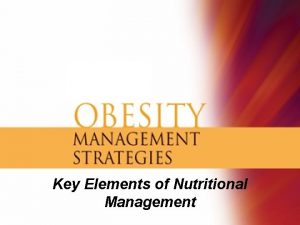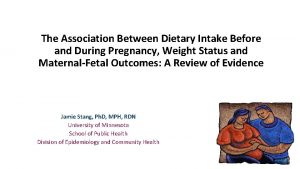Measuring dietary intake in athletes Dr Kristen Mac

































- Slides: 33

Measuring dietary intake in athletes Dr Kristen Mac. Kenzie-Shalders Bond Institute of Health & Sport, Bond University, Robina, AUSTRALIA. CRICOS CODE 00017 B

IO NS Application of specific sports foods. Matching nutrients to exercise to enhance performance, adaptation and recovery. HI ER AR CH Y O F S PO RT S N UT RIT IO N IN T ER VE NT Supplements The whole diet as the foundation of health and performance.

Dietary measurement and prescription It’s a tricky business Difficulties effectively measuring Difficulties effectively prescribing

Today • Dietary methodology: observations and experiences • Research & developments • Limitations and future directions

Dietary assessment in athletes Body composition Energy requirements Diet quality Nutrient requirements Image Source

Dietary energy Can’t forget growth in some athletes. Accurate measurement/ prediction and thus prescription

The measurement of energy expenditure (and thus requirements) RMR PA • DLW technique – potentially increased sources of error. • ~moderate agreement between EI/EE in athlete populations – tend towards underestimation of energy intake. DIT

The measurement of energy expenditure (and thus requirements) RMR • Systematic review of methodology • Minimum restriction of physical activity for 14 hours suggested for heavy exercise (Grade III) • Fasting period Compher, C. , Frankenfield, D. , Keim, N. , & Roth-Yousey, L. (2006). Best Practice Methods to Apply to Measurement of Resting Metabolic Rate in Adults: A Systematic Review. Journal of the American Dietetic Association, 106, 881 -903. PA DIT

Considerations for testing RMR in athlete populations • The stress associated with the measurement and the ventilated hood • Intake of stimulants before the measurement, some common items as caffeine, nicotine and alcohol and some supplement ingredients • Recent food intake, acute changes in DIT will artificially inflate the RMR measurement and chronic energy deprivation will depress RMR (Bullough et al. , 1995) • A change in physiological state including illness, certain medications or exposure to high altitudes or high altitude simulated environments (Manore & Thompson, 2006) • Physical activity including on the day preceding the measure and the method used to travel to the site of measurement. • Menstrual cycle phase

The measurement of energy expenditure (and thus requirements) RMR • Spontaneous physical activity & thermic effect of activity • Algorithms based on movement monitors or physical activity diaries • Complex movements performed by many athletes in different conditions. PA DIT

Changes in RMR with training • A minimum change of 6 – 8% is required to discount the effect of usual daily variations in RMR (Roffey et al. , 2006). N= 18 Pre measure Post measure Change value Confidence Significance Mean & SD ~ 14 weeks Interval (P value) Height 184. 0 ± 8. 4 184. 5 ± 8. 3 + 0. 5 ± 0. 7 0. 1 -0. 9 < 0. 01 Body Mass (kg) 101. 2 ± 14. 5 102. 0 ± 13. 2 + 0. 8 ± 2. 3 -0. 4 - 1. 9 0. 18 Lean Mass (kg) 76. 9 ± 7. 6 78. 8 ± 8. 1 + 2. 0 ± 1. 5 1. 2 - 2. 7 < 0. 01 Fat mass (kg) 20. 4 ± 8. 7 19. 9 ± 7. 2 - 0. 5 ± 2. 4 - 1. 7 - 0. 7 0. 40 RMR (kcal·day-1) 2389± 263 2373± 270 - 16 ± 79 -55 - 23 0. 39 Average HR (bpm) 54 ± 5 52 ± 6 - 3 ± 4 - 5 - 0 0. 02 Average RER 0. 70 ± 0. 04 0. 74 ± 0. 36 + 0. 04 ± 0. 04 0. 02 - 0. 05 < 0. 01 Source. Thesis: Kristen Mac. Kenzie

The measurement of energy expenditure (and thus requirements) RMR • Protein/energy intake may be higher or lower, applications for DIT PA DIT

The prediction of energy expenditure (and thus requirements) RMR PA DIT

Challenges for the effective prediction of RMR in athletes • Few studies in athletes eg. Thompson & Manore 1996; Carsholn et al (2011) • Total body mass (TBM) and lean mass (LM) highly predictive

Common prediction equations used with athletes Author Year Equation Study Population Considerations of use Harris-Benedict (HB) kcal·day-1 1919 RMR = (13. 7516 * Wt) + (5. 0033 * HTCM) – (6. 7550*Age) + 66. 4730 N = 239 (136 Males) Age for male subjects (27 ± 9 years) College and faculty members, unknown ethnicity and n = 16 athletes Re-analysis of Harris-Benedict data (as above) Athletes (n = 16) from HB data were eliminated - Cunningham kcal·day-1 De Lorenzo kcal·day-1 Schofield 1 MJ·day-1 1980 1999 1985 RMR =500 + (22 * LBM) - - RMR = -857 + (9. 0 * WT) 51 Italian male athletes + (11. 7 * HTCM) Age 23. 3 ± 3. 5 22 Water polo players 12 Judo athletes 17 Karate athletes - RMR = (0. 063 X Wtkg) + 2. 896 - Source. Thesis: Kristen Mac. Kenzie Italian Subjects n=7173 (4809 M, 2364 F) - Population used considered lean in comparison to general population Some athletes included (approx. 7% population) Requires weight, height and age of athlete LM was derived value calculated retrospectively from HB data, not directly measured Equation used to simplify HB data by using LM only, however many athletes have limited access to LM. Was developed as assessment found that most equations underestimated athletes requirements (except Cunningham which over-estimated) LM explained 57% of variance in RMR while body weight and height explained 78% Commonly used in Australia Based on over 8000 measurements and more recent

Under-predicted due to body composition? Metabolic increase? What about energy-efficiency?

Challenges for the effective prediction of RMR in athletes • LM derived equations more representative? Tissue Type Usual weight 70 kg man (kg) Liver 1. 6 Brain 1. 4 Heart 0. 32 Kidney 0. 29 Muscle 30. 00 MR/day (Kcal) 482 338 122 187 324 Kinney J. M & Elia M. (1992) in Organ and tissue contribution to metabolic rate. in Energy Metabolism: Tissue Determinants and Cellular Corollaries, ed Kinney J. M. (Raven, New York), pp 61– 77. Approximate metabolic rate per gram tissue (derived) 0. 30 kcal/g 0. 24 kcal/g 0. 38 kcal/g 0. 64 kcal/g 0. 01 kcal/g

Can we improve predictability? B = C + B o Mb b = 1 for a linear model b = ¾ for exponential model b = ? for our model. . ? Lean mass compartmental prediction: has been shown to be more predictive in general population (Kistorp et al, 2000) RMR = …. x Trunk LM + …. x Head LM + …. x Limbs LM

But what is ‘lean mass’? Body composition assessment methods • Lean-mass index? • Fat-free mass? • What method & procedure?

Variability of energy expenditure 424 average TEE measurements in military personnel which ranged from 13. 0 to 29. 8 MJ per day (Tharion et al. , 2005).

Dietary assessment: macronutrients Image Source

Case study: Can you see any difference? Body composition Developing elite rugby union athletes (n = 25) (n = 24) Pre-season 2012 Pre-season 2013 Body weight (kg) 100. 2 ± 13. 3 101. 6 ± 11. 6 Lean mass (kg) 77. 0 ± 7. 0 75. 6 ± 5. 3 Height (cm) 184. 4 ± 7. 5 186. 4 ± 7. 4

Case study: Dietary intake assessment Group 1 Group 2 (Mean ± SD) Protein intake (g·kg·day-1) 2. 2 ± 0. 7 2. 7 ± 0. 6 Protein intake (g·day-1) 210. 9 ± 61. 5 272 ± 45 Energy intake (k. J·day-1) 13604. 9 ± 3638. 5 15766 ± 3673 Energy intake (k. J·kg·day-1) 139. 61 ± 45. 1 157 ± 45 Carbohydrate intake (g·day-1) 352. 0 ± 115. 1 363 ± 113 Carbohydrate intake (g·kg·day-1) 3. 61 ± 1. 32 3. 6 ± 1. 3 Fat intake (g·day-1) 101. 32 ± 34. 2 125 ± 36 Fat intake (g·kg·day-1) 1. 05 ± 45. 1 1. 3 ± 0. 4 Dietary Intake 7 day food diary 7 x 24 -hr recalls

The best dietary assessment method to use with athletes Image Source

Nutrition Bulletin Volume 26, Issue 1, pages 29 -42, 7 JUL 2008 DOI: 10. 1046/j. 1467 -3010. 2001. 00096. x http: //onlinelibrary. wiley. com/doi/10. 1046/j. 1467 -3010. 2001. 00096. x/full#f 2

Dietary distribution/patterns Defined ‘eating occasions’ Breakfast: 0500– 0959 Morning tea: 1000– 1159 Lunch: 1200– 1459 Afternoon tea: 1500– 1759 Dinner: 1800– 2059 Evening snack: 2100– 0459 Training: all energy-containing foods and fluid consumed during a workout Burke, L. M. , Slater, G. J. , Broad, E. M. , Haukka, J. , Modulon, S. , & & Hopkins, W. G. (2003). Eating patterns & meal frequency of elite Australian athletes. International Journal of Sport Nutrition and Exercise Metabolism, 13, 521 -538.

Dietary distribution/patterns

Methodological definitions and abbreviations Eating occasion (EO) When energy-containing food or fluid were consumed, these were deemed as separate if they were > 30 minutes apart otherwise they were deemed to be the same eating occasion. Individual Protein Target (IPT) 0. 3 g weighed body weight (kg) Protein Distribution Score IPT The number of eating occasions per day containing over the IPT averaged across the week. Protein Distribution Score 20 The number of eating occasions per day containing over 20 g of protein averaged across the week Excess Protein Estimation Score The mean number of eating occasions per day with greater than 1. 5 x the calculated IPT (EPES) Post Resistance Exercise Protein The number of eating occasions immediately after resistance exercise containing over 20 g of protein averaged across the week. Protein Supplementation Distribution Score 20 g Protein Consumption after 8. 00 pm The number of eating occasions containing more than 20 g of protein averaged across the week that included supplemental protein or skim milk powder. The number of eating occasions averaged across the week where more than 20 g of protein was consumed after 8. 00 pm.

Do we systematically under-report specific nutrients?

Practicalities & challenges • Emerging technologies all prospective • No current validated FFQ’s (for macronutrients) • Heterogeneity of athlete groups and dietary intake practices • Importance of publication of data – adds to dialogue

Acknowledgements Professor Neil King 1 Professor Nuala Byrne 2 Dr Gary Slater 2 1. School of Exercise & Nutrition Sciences, Queensland University of Technology, Brisbane, AUSTRALIA. 2. Bond Institute of Health & Sport, Bond University, Robina, AUSTRALIA. 3. School of Health and Sport Sciences, University of the Sunshine Coast, Sippy downs, AUSTRALIA. Energy Metabolism Group (QUT IHBI) Bond University/Bond Institute of Health & Sport NHMRC/APA

Thank you – questions?

References • • • Kinney J. M & Elia M. (1992) in Organ and tissue contribution to metabolic rate. in Energy Metabolism: Tissue Determinants and Cellular Corollaries, ed Kinney J. M. (Raven, New York), pp 61– 77. Manore, M. M. and J. L. Thompson, Energy requirements of the athlete: assessment and evidence of energy efficiency. Clinical Sports Nutrition, ed. L. M. Burke and V. Deakin. Vol. 3 rd Edition. 2006, Sydney: Mc. Graw-Hill. Levine, J. A. , Measurement of energy expenditure. Public Health Nutrition, 2007. 8(7 a). Nutrient Reference Values for Australia and New Zealand, D. o. H. a. Aging, Editor. 2005, Commonwealth of Australia. Thompson, J. L. , Energy balance in young athletes. International Journal of Sport Nutrition, 1998. 8(2): p. 160174 Thompson, J. , & Manore, M. M. (1996). Predicted and Measured Resting Metabolic Rate of Male and Female Endurance Athletes. Journal of the American Dietetic Association, 96(1), 30 -34. doi: 10. 1016/s 00028223(96)00010 -7 Carlsohn, A. , Scharhag-rosenberger, F. , Cassel, M. , & Mayer, F. (2011). Resting Metabolic Rate in Elite Rowers and Canoeists: Difference between Indirect Calorimetry and Prediction. Annals of Nutrition & Metabolism, 58(3), 239 -244. Burke, L. M. , Slater, G. J. , Broad, E. M. , Haukka, J. , Modulon, S. , & & Hopkins, W. G. (2003). Eating patterns & meal frequency of elite Australian athletes. International Journal of Sport Nutrition and Exercise Metabolism, 13, 521 -538. Compher, C. , Frankenfield, D. , Keim, N. , & Roth-Yousey, L. (2006). Best Practice Methods to Apply to Measurement of Resting Metabolic Rate in Adults: A Systematic Review. Journal of the American Dietetic Association, 106, 881 -903.
 Athletes vs non athletes academic performance
Athletes vs non athletes academic performance Mac mac o kok dac
Mac mac o kok dac Who was the real macbeth
Who was the real macbeth The presence of spectators helps young athletes
The presence of spectators helps young athletes All athletes have an innate preference
All athletes have an innate preference Anthony rizzolo
Anthony rizzolo Should college athletes be paid thesis statement
Should college athletes be paid thesis statement Athletes suddenly dying
Athletes suddenly dying Are fungi multicellular
Are fungi multicellular Most fad diets do follow the mypyramid guidelines
Most fad diets do follow the mypyramid guidelines Hhmi biointeractive sex verification testing of athletes
Hhmi biointeractive sex verification testing of athletes Harlem renaissance athletes
Harlem renaissance athletes Famous athletes with osgood schlatters disease
Famous athletes with osgood schlatters disease Goal setting theory
Goal setting theory 6 word memoirs about basketball
6 word memoirs about basketball Athletes body engineers
Athletes body engineers Dietary supplement questionnaire
Dietary supplement questionnaire Mealtracker dietary software
Mealtracker dietary software Dietary exchange system
Dietary exchange system Cbc iron levels
Cbc iron levels Dietary habits questionnaire
Dietary habits questionnaire Sepsis dietary management
Sepsis dietary management Dietary supplements meaning
Dietary supplements meaning Mechanically altered diet
Mechanically altered diet Dietary supplement formulation
Dietary supplement formulation Dietary manipulation in sport definition
Dietary manipulation in sport definition Vitamin k dietary sources
Vitamin k dietary sources What are the scottish dietary goals
What are the scottish dietary goals Breakfast for a sedentary worker
Breakfast for a sedentary worker Dietary acculturation
Dietary acculturation Lymfangiectasie
Lymfangiectasie Theravada meal chant
Theravada meal chant Dietary management of diabetes
Dietary management of diabetes Perbedaan syahadat para rasul dan syahadat nicea
Perbedaan syahadat para rasul dan syahadat nicea





